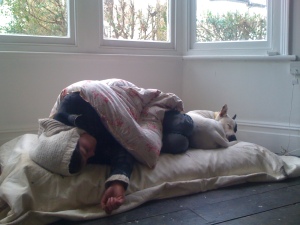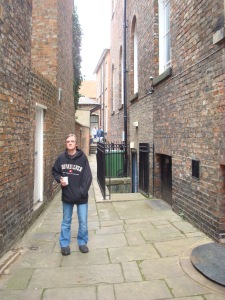Jane 21/11/11
I’ve ended up with this dog, Marmite yeah? It’s young and I’m sorry to say I can’t do nothing with it. I mean, you know me, you know I’ve always had dogs and… Patch.., and, you know I have nice dogs. But this one’s like some crazy fighting dog and I didn’t choose to have him. It’s a long story but I ended up with this crazy dog called Red and I’m quite pissed off. I mean, if I took him to the pound, I’d have everyone on my back saying I’m a dog murderer because that’s what they do to dogs, dangerous dogs, at the pound.
I’ve got a cat too. I’m not sure whether to call him Bageera or Mario. I like Bageera.
I went to the doctor because he knows I’ve been doing this project with you over the last years or few. I went in and used to tell him I was an archaeologist and then he asked me if I would spoke to his medical students and I told them the truth about addiction. When I went to see him the other day, just at the surgery, I took him in this book that you sent me – Alexander Masters, Stuart: a life backwards – and he wanted to borrow it. I said he couldn’t have it because it was a gift from a friend and he just wrote down what it was called.
See, you get some people who are embarrassed to admit they can’t read. That’s it really. I can read, but loads of people on the street, you find out, after a while, they can’t. I had this idea to make my book so it come out with a CD of the music that goes with the times I’m talking about. So the people who can’t read can still get the gist of what it’s all about.
Thing is, the internet has all the music on it and it’s not cheap, Marmite, is it? The internet, I mean. I tried to get that…what’s it called? That Broadmend thing… what’s it called? Broadband. It wasn’t even wired up close to my place now. So I give up on that internet and instead, I was working out what music I’d put on the CD:
Red Eyes – Beautiful South – cos’ it’s about alcoholism
You ain’t goin’ nowhere – Bob Dylan
Family Portait – Pink – it reminds me of my kids. If you look at the video, the girl is following the mother and then the mother stays the same and the little girl ends up going in with a really Kosher, what is classed as a proper family, and the mum is just an alcoholic. If you look into it deeply, we’re all statistics, that’s what that video says to me.
Losing my Religion – REM
Everybody hurts – REM
Better to burn out than fade away – Neil Young
Strange little girl – Stranglers
Freebird – Lynard Skynard
Born to be wild – but I don’t know who did it
Stairway to Heaven – Led Zepplin
Suspicious Minds – Elvis Presley
Beautiful and Goodbye my love – James Blunt
Driftwood – Travis
Lives in a windowsill – Travis
Sing – Travis
Knock three times on a ceiling if you wanna…I ain’t got a clue who that’s by. It’s about three or four years’ old. Heard it on the radio and loved it.
I will always love you – Whitney Houston
Fast Car – Tracy Chapman
Son of a Preacher Man – it’s on that CD Jake made for me. Wicked song that!
Under the Bridge – Chilli Peppers
By the way – Chillis – that’s when my kids got taken off me. My boy used to sing it to me.
Over the Rainbow – it’s on old black and white films.
Don’t worry be happy –
Angel – Robbie Williams – that’s the rehab’ I went to. It’s called Clouds. I actually sat in the seat that Robbie Williams sat in when he made that song. As you walk into the room, you got angels round the coving of the room…you’re meant to go for the serenity and peace and all that…there’s a fishpond and that’s where he – Robbie… he got that song from there. Everyone thinks it’s love song and it’s not.
27 Club – Jimi, Janice, Kurt and now Amy – they all died from drugs at 27 and that – Teen Spirit was about that. He didn’t realise that it was about that.
Tugthumping – Chumba Womba
Don’t bring Sally – Stranglers – it’s about smack.
That’s all jumble wumbled. But when I get it in the right order, it’ll be a killer album. My next door neighbour thinks I’m brilliant now. He’s really encouraging now that I’ve shown him I am writing stuff and he can see I’m serious. I told Whistler too. He’s got God but he thinks I’m doing well.











